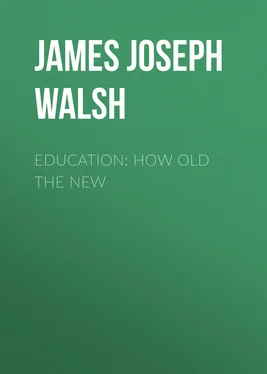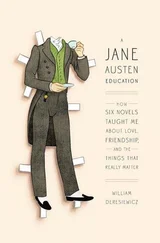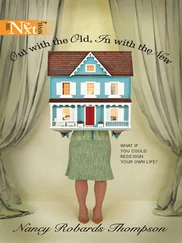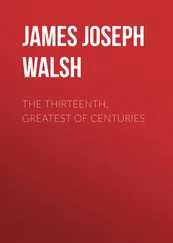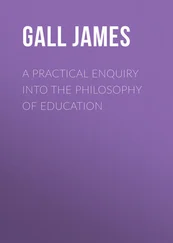James Walsh - Education - How Old The New
Здесь есть возможность читать онлайн «James Walsh - Education - How Old The New» — ознакомительный отрывок электронной книги совершенно бесплатно, а после прочтения отрывка купить полную версию. В некоторых случаях можно слушать аудио, скачать через торрент в формате fb2 и присутствует краткое содержание. Жанр: foreign_prose, foreign_edu, foreign_antique, на английском языке. Описание произведения, (предисловие) а так же отзывы посетителей доступны на портале библиотеки ЛибКат.
- Название:Education: How Old The New
- Автор:
- Жанр:
- Год:неизвестен
- ISBN:нет данных
- Рейтинг книги:3 / 5. Голосов: 1
-
Избранное:Добавить в избранное
- Отзывы:
-
Ваша оценка:
- 60
- 1
- 2
- 3
- 4
- 5
Education: How Old The New: краткое содержание, описание и аннотация
Предлагаем к чтению аннотацию, описание, краткое содержание или предисловие (зависит от того, что написал сам автор книги «Education: How Old The New»). Если вы не нашли необходимую информацию о книге — напишите в комментариях, мы постараемся отыскать её.
Education: How Old The New — читать онлайн ознакомительный отрывок
Ниже представлен текст книги, разбитый по страницам. Система сохранения места последней прочитанной страницы, позволяет с удобством читать онлайн бесплатно книгу «Education: How Old The New», без необходимости каждый раз заново искать на чём Вы остановились. Поставьте закладку, и сможете в любой момент перейти на страницу, на которой закончили чтение.
Интервал:
Закладка:
Its date would be about 3650 B.C. if we were to follow,–as does the translator of the most easily procurable English edition, Mr. Gunn,–the chronology of Flinders Petrie. Recent advances in our knowledge of Egyptology, however, have brought the dates nearer to us than they were placed before. Such men as Breasted of Chicago, and Maspero, would probably take from three hundred to five hundred years from this date. There is a definite tendency in all the histories to bring dates much nearer to the present than before. For a time, the older one could place a date the more scholarly seemed to be the appeal of such an opinion. Now the tendency is all the other way. Even the latest date that can be given for Ptah Hotep, or Phtahhotpû, would still make his little book the oldest book in the world, however.
Fortunately for us the manuscripts of the instructions of Ptah Hotep that have come down to us are in much better condition than those of most of the other instructions of similar kinds formerly used in the schools that have been preserved. In some of these there are a great many errors of writing, spelling and grammar with the corrections of the master above in a different-colored ink. Verily, education has not changed much in spite of six millenniums, or very nearly so, of supposed progress since these were written, for the whole process is as familiar as it can be. As Mr. Battiscombe Gunn says in his Introduction to his edition "a schoolboy's scrawl over 3,000 years old is no easy thing to translate." We would seem, however, to have been blessed in the preservation of this oldest book in the world, either of the original copies set by the masters or of such copies as were made by advanced students. The series of lucky chances that have combined to bring to us, in the comparatively perfect form in which it exists, this oldest book in the world is interesting to contemplate. Without them we would have no idea of how closely the first people of whom we have any definite records in history resembled us in every essential quality of humanity, even to the ways and modes by which they tried to lift humanity out of the barbaric selfishness inherent in it to what is higher and nobler in its nature.
With this surprising resurrection of our school-teaching methods from the past it is interesting to study other phases of the education of these early times, and at the same time to note the accomplishments of the men, of the period, their tastes, the state of their culture as regards the arts and crafts and personal adornment and the decoration of their houses and buildings of various kinds. Flinders Petrie, the distinguished English Egyptologist, in an article on "The Romance of Early Civilization," printed recently in The Independent (New York), said:
"We have now before us a view of the powers of man at the earliest point to which we can trace written history, and what strikes us most is how very little his nature or abilities have changed in seven thousand years; what he admired we admire; what were his limits in fine handiwork are also ours. We may have a wider outlook, a greater understanding of things, our interests may have extended in this interval; but as far as human nature and tastes go, man is essentially unchanged in this interval."
We have enough of the products of the arts and crafts of these early Egyptian generations to show us that there must have been no inconsiderable training of the men of this time in the making of beautiful art objects. For instance, the interior decoration of their tombs shows us men skilled as designers, clever in the use of colors, with a rather extensive knowledge of pigments and with a definite tendency not to repeat designs but to create new ones. Most of the diapered designs of modern interior decorations were original with the Egyptians, and some of those found in the tombs uncovered in recent years have been adopted and adapted by modern designers. It is in the matter of jewelry particularly that the ability and the training of the old Egyptian workmen are most evident. It would be quite incredible to think that these workmen developed their artistic craftsmanship without training, and therefore there was at least the germ of a technical school or set of schools in oldest Egypt. It would be quite impossible to believe this only that we know so much more about other features of Egyptian education as anticipations of our own. A special word about their jewelry then, because it illustrates a definite training quite different from that of our time, will not be out of place.
Their jewelry, it may be said at once, is in striking contrast with what we call jewelry in our time. It is true that we are in the midst of one of the worst periods of jewelry-making, but then we are so prone to think of anything very modern as representing the highest evolution, that the contrast is chastening and illuminating. Mr. Petrie has insisted on the beautiful jewelry, carved precious stones and gold ornaments of the very early period in Egypt. In our time we have no jewelry that deserves the name. I doubt whether we even know the real definition of jewelry, so I venture to repeat it. Jewels are precious stones themselves of value, usually of a high degree of hardness so that they do not deteriorate with time or wear, to which a greatly enhanced value is added by the handiwork of man. Jewels are made by artistic carving and cutting so that besides their precious quality as beautiful colored stones, they have an added charm and interest from human workmanship. We wear no such jewelry in our generation. What we have are merely precious stones. These by an artificial rigging of the market and a combination of the great commercial agencies that control the sale of diamonds and other precious stones, remain very expensive in spite of their comparative abundance. They are worn only because they are a display of the amount of money that a person can afford to spend for mere ornaments.
There is nothing in these precious stones themselves that carries an appeal to the educated mind. It is true that they are pretty, but only with the prettiness of the play of rainbow colors that delights a childish or uncultured eye. It requires no taste to like them, no culture to appreciate them, and their cost alone gives them value. This is so true that those who possess a magnificent parure of diamonds often also have an imitation of them in cheaper stones that may be worn on most occasions. The danger of loss or the risk of robbery is so great that it has seemed worth while to have this imitation made in many cases. No one except an expert will recognize the difference, and if you are known to possess the real stones it will of course be supposed that you are wearing them. What gives them value as an adornment in the eye of the possessor, and presumably also of the onlookers, is the fact that they must have cost such a large sum of money. They are a vulgar display of wealth. They are typically barbaric and, worn in the profusion now so common, carry us back to the uncultured peoples who like to wear gaudy things. The taste is perhaps a little better, but the essential quality of mind that dictates the wearing of heavy brass rings and strings of beads and that which impels to the display of many diamonds, is hard to differentiate.
Artistic objects produce a sense of pleasure in the beholder, an appreciation of the beautiful handiwork of man. Precious stones worn as is now the custom produce only a sense of envy. Of course envy comes only to baser minds, but it is perfectly clear that most of those who are supposed to be affected by the sight of diamonds worn in profusion have this particular quality rather well developed. This distinction is often forgotten. Personal adornment as well as the adornment of one's house should be in order to give pleasure to others, and not merely a display of wealth for wealth's sake in such a way as is likely to produce envy. The old Egyptians made their jewelry with the true artistic sense. Flinders Petrie has told how beautifully they carved hard gems of various kinds and how the remains of these show us a people of good taste, even though their technique in the manufacture of such objects may have left something to be desired. In connection with this oldest of books it is important to recall this, for it shows that not alone in the applied wisdom of life and the knowledge gained from personal experience were these Egyptians of over 5,000 years ago brothers and sisters beyond whose wise saws we have not advanced, but also in the realm of art their work takes its place beside what is best in the modern time.
Читать дальшеИнтервал:
Закладка:
Похожие книги на «Education: How Old The New»
Представляем Вашему вниманию похожие книги на «Education: How Old The New» списком для выбора. Мы отобрали схожую по названию и смыслу литературу в надежде предоставить читателям больше вариантов отыскать новые, интересные, ещё непрочитанные произведения.
Обсуждение, отзывы о книге «Education: How Old The New» и просто собственные мнения читателей. Оставьте ваши комментарии, напишите, что Вы думаете о произведении, его смысле или главных героях. Укажите что конкретно понравилось, а что нет, и почему Вы так считаете.
